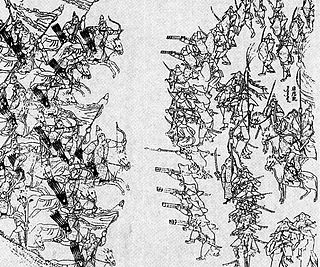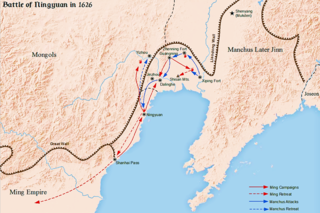
The Battle of Sarhū refers to a series of battles between the Later Jin dynasty and the Ming dynasty and their Joseon allies in the winter of 1619. The battle is notable for the heavy use of cavalry by the Later Jin in defeating Ming and Joseon forces equipped with hand cannons, cannons, and matchlocks.

The Later Jin invasion of Joseon occurred in early 1627 when the Later Jin prince Amin lead an invasion of Korea's Joseon kingdom. The war ended after three months with the Later Jin establishing itself as sovereign tributary overlord over Joseon. However Joseon continued its relationship with the Ming dynasty and showed defiance in solidifying its tributary relationship with the Jurchens. It was followed by the Qing invasion of Joseon in 1636.

The Qing invasion of Joseon occurred in the winter of 1636 when the newly established Manchu Qing dynasty invaded Korea's Joseon kingdom, establishing its status as the center of the Imperial Chinese Tributary System and formally severing Joseon's relationship with the Ming dynasty. The invasion was preceded by the Later Jin invasion of Joseon in 1627.

Yuan Chonghuan, courtesy name Yuansu or Ziru, was a politician, military general and writer who served under the Ming dynasty. Widely regarded as a patriot in Chinese culture, he is best known for defending Liaoning from Jurchen invaders during the Later Jin invasion of the Ming. As a general, Yuan Chonghuan excelled as a cannoneer and sought to incorporate European cannon designs into the Ming arsenal.

The Battle of Ningyuan was a battle between the Ming dynasty and the Jurchen Later Jin in 1626. The Jurchen Later Jin had been waging war on the Ming for several years, and their leader Nurhaci had deemed Ningyuan to be a suitable target for his attack, in part due to advice from a Chinese defector, Li Yongfang. Later Jin failed to take the city and Nurhaci was wounded in the assault, dying eight months later. The Ming emerged victorious, marking a temporary resurgence of the Ming army after an eight-year-long series of defeats.
Kong Youde was an adventurer and Ming dynasty military officer who served under the warlord Mao Wenlong until Mao's death in 1629. Subsequently he worked for Sun Yuanhua, governor of Shandong, along with fellow Mao subordinate Geng Zhongming. When ordered by Sun to reinforce Zu Dashou at the Battle of Dalinghe in 1631, Kong and Geng mutinied, pillaging the countryside, sacking Dengzhou, and subsequently defecting to Manchu invaders—soon to declare themselves China's Qing Dynasty—in 1633. They were joined in 1634 by another former officer under Mao, Shang Kexi. Together, the three were known as the "Three Miners from Shandong" and participated in many campaigns under the Qing dynasty, hastening the demise of the Ming.

The Later Jin was a khanate in Manchuria ruled by the Jurchen Aisin Gioro clan from 1616 to 1636, and was the predecessor of the Qing dynasty. In 1616, the Jianzhou Jurchen chieftain Nurhaci declared himself the khan of the Jurchen nation and adopted the name of the former Jurchen-led Jin dynasty for the state. In 1635, the Northern Yuan dynasty under Ejei Khan formally submitted to the Later Jin. The following year, Hong Taiji officially renamed the realm "Great Qing", which later became a Chinese dynasty that bore the Mandate of Heaven for nearly three centuries after its conquest of China proper. The Later Jin existed for 20 years and was ruled by two khans.

The Battle of Fushun was the first military conflict in the war between the Jurchen-led Later Jin and the Ming dynasty. The battle ended in a decisive victory for the Later Jin and resulted in the capture of Fushun and two other nearby fortresses.
The Battle of Qinghe was a military conflict between the Jurchen Later Jin and Ming dynasty in the summer of 1618. The battle ended with the Jin conquest of Qinghe despite taking heavy casualties.

The Battle of Kaiyuan was a conflict between the Later Jin and Ming dynasty in the summer of 1619. Following the victory at the Battle of Sarhu, Nurhaci continued the attack on Ming by assaulting the city of Kaiyuan.
The Battle of Tieling was a military conflict between the Later Jin and Ming dynasty. In the summer of 1619 Nurhaci invaded the town of Tieling, the ancestral home of the Li clan. Ming had fortified the town with cannons, but many of their soldiers defected to the Jin, and they were unable to reload their cannons before the walls were taken. Li Ruzhen, one of the last scions of the Tieling Li, fled the battle.

The Battle of Xicheng was a military conflict between the Yehe Jurchens, their Ming allies, and the Later Jin. In the fall of 1619 Nurhaci invaded Xicheng, the home of the Yehe Jurchens. Nurhaci personally led the vanguard and took the east wall. After capturing the city the Yehe inhabitants were spared, but their Ming allies who had fought beside them were executed.

The Battle of Guanging was a military conflict between the Manchu forces of the Later Jin and the Ming dynasty of China. It occurred at and around the Ming's northern city of Guangning, which fell to the Later Jin in 1622.

The Battle of Ning-Jin was a military conflict between the Later Jin and Ming dynasty. In the spring of 1627 the Jin khan Hong Taiji invaded Ming territory in Liaoning under the pretext of illegal construction on Jin lands.
The Jisi Incident (己巳之變) was a military conflict between the Later Jin and Ming dynasty, named because it happened in 1629, a jisi year according to the Chinese sexagenary cycle. In the winter of 1629 Hong Taiji bypassed Ming's northeastern defenses by breaching the Great Wall of China west of the Shanhai Pass and reached the outskirts of Beijing before being repelled by reinforcements from Shanhai Pass. The Later Jin secured large amounts of war material by looting the region around Beijing. This was the first time the Jurchens had broken through the Great Wall into China proper since they rose up against Ming China.
The Wuqiao mutiny (吳橋兵變) was a soldier rebellion from 1631 to 1633 during the late years of Ming Dynasty, led by Kong Youde and Geng Zhongming, both of whom were lieutenants under the command of general Mao Wenlong, the defender of Pi Island.
Li Yongfang was a general of the Ming dynasty and Qing dynasty best known for being the first general defecting to the Qing dynasty, due to the Ming dynasty losing the city of Fushun in Liaoning to the Qing.
The Jurchen unification was a series of events in the late 16th and early 17th centuries that led to the unification of the Jurchens under Nurhaci.
















